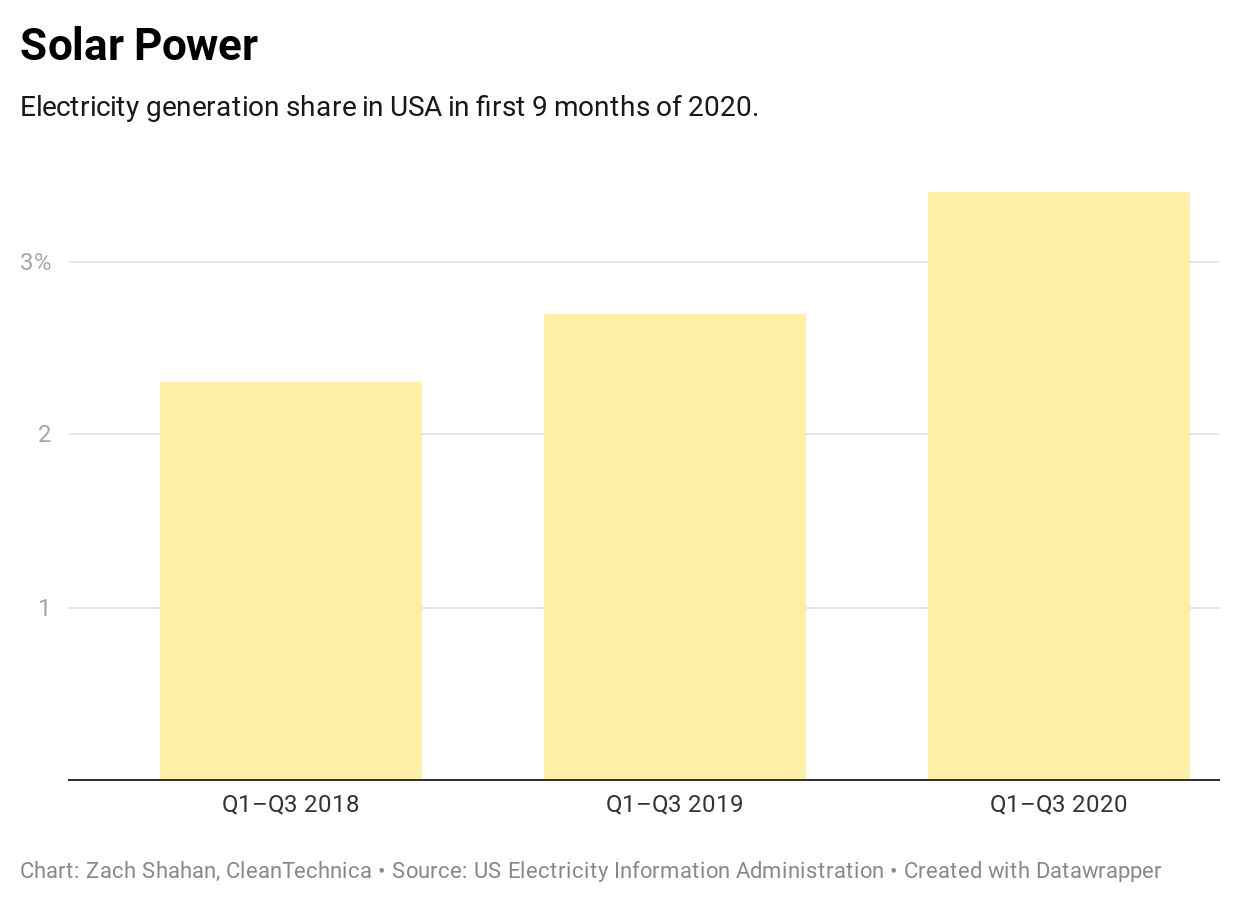November 30th, 2020 by Zachary Shahan
In the first 3 quarters of 2020, while renewable energy accounted for 70% of new power capacity in the country, it still accounted for just 20.4% of total electricity generation in those 9 months.
That’s down a bit from the 22.2% share that renewable energy held in the first 6 months of the year. As the economy has come back to life a bit, electricity demand has risen again, leading to a need for more non-renewable sources.
Breaking things down further, solar and wind power together accounted for 11.3% of US electricity generation, also down a bit from the 12.5% share these two held in the first half of the year.
However, comparing the market share of the first 9 months versus the first 6 months is not the most compelling way to evaluate trends. Instead, it’s worth looking deeper and comparing the first 9 months of 2020 to the first 9 months of 2019 and 2018. From that perspective, 2020’s figure of 20.4% is up from 18.4% renewable energy share in the first 9 months of 2019 and 17.6% renewable energy share in the first 9 months of 2018.
Furthermore, solar and wind’s 11.3% share of 2020 US electricity production is up from 9.5% in the first 9 months of 2019 and 8.7% renewable energy share in the first 9 months of 2018.
Solar has gained 1.1% market share since 2018 and wind has gained 1.5% market share. This may feel like slow movement. Well, yeah, it certainly does. However, the US electric grid is humongous, and power plants built years or decades ago do not close down overnight. So, even as 70% of new power capacity is from renewables, renewables only grow their share of overall electricity generation across the grid by a couple of percentage points a year. Think of it like the US vehicle fleet — even if 70% of new vehicles were electric, there’d be many gasoline vehicles remaining on the road, because new vehicles are a small portion of the overall vehicle fleet driving on roads across the country every day. (Side note: that’s another problem.) Or think of it like your pantry, but days are years. Perhaps you buy some new cookies, but you still need to spend a few days or even weeks (not me) clearing through your existing cookies before you start eating the new ones. (Right?)
Anyway, cookies and cars aside, let’s close on a fun chart. The next and final chart is a chart of coal’s rather sharp decline over the past few years. That decline is due to both the rise of renewables and the rise of natural gas (here’s a link to that chart, but it’s not such a fun one when you consider all the greenhouse gas emissions, and especially methane leaks, that still result from natural gas use).
Oh, one more thing. Following the previous quarterly report on US electricity sources, one of our faithful readers and great commenters noted the following:
“Something that ‘everybody knows’ is that you ‘need’ batteries if you are going to have solar/wind on your grid.
“But it is my understanding that the amount of batteries (or other grid scale storage) in the US is currently pretty small, both in absolute amounts (how much we can store) and in usage (how frequently we fill/empty them).
“That’s likely to change as we start pushing towards 100% RE, but talking about where the storage numbers are right now and how they’ve been changing as %RE grows would be interesting.”
It’s a great point and interesting matter. So, I looked into battery storage figures as well. On page 185 of this EIA report, I found the following table:
Confusing? Unclear what these figures stand for? The following description may help:
“Values for 2019 and prior years are final. Values for 2020 are preliminary. Time adjusted capacity for month rows is the summer capacity of generators in operation for the entire month; units that began operation during the month or that retired during the month are excluded. Time adjusted capacity for year rows is a time weighted average of the month rows. Usage factors are a comparison of gross generation with available capacity. See the technical note for an explanation of how usage factors are calculated.”
Still confusing? I agree. Nonetheless, what is clear is you can see the trends. You can see how much battery energy storage use is growing. Usage increased more in the pasts few months than from July 2018 to December 2019.
Related reports:
Appreciate CleanTechnica’s originality? Consider becoming a CleanTechnica member, supporter, or ambassador — or a patron on Patreon.
Sign up for our free daily newsletter or weekly newsletter to never miss a story.
Have a tip for CleanTechnica, want to advertise, or want to suggest a guest for our CleanTech Talk podcast? Contact us here.




